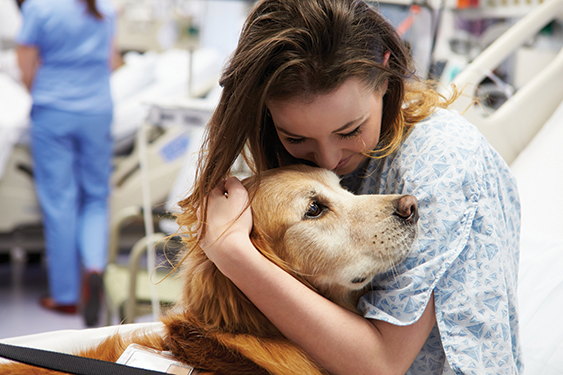Susan Grill of Trained and Maintained Shares What Takes to be a Service or Therapy Dog
by TERESA SCHIFFER
They say that the dog is man’s best friend. If the dog is a service or therapy animal, that’s true in more ways than one. These special pooches save lives, provide assistance and comfort, and help the disabled while keeping their cool in stressful situations. It’s all in a day’s work for these extraordinary animals. Susan Grill, of Trained and Maintained in Orlando, can personally attest to the training process and the abilities of these four-legged heroes.
The training starts early, as puppies are chosen by temperament. One technique used by trainers to test if a puppy is suited for training is to slam a can of pennies down behind the pup. If he doesn’t respond, he’s a good candidate for training. These puppies need to be unbothered by people pulling on their tails or startling them because when you’re a working dog you can’t afford to snap at people who annoy you.
There are many applications for service dogs, which are a little different from therapy dogs. Therapy dogs go into an environment to be interacted with for therapeutic purposes. They may visit Alzheimer’s patients, people suffering from PTSD, hospital wards, and more. Therapy dogs need to be calm and personable, but they work with many different people. Service dogs are assigned to one particular person. Many people are familiar with service dogs for the blind, but they can also alert their owners to drops in blood sugar levels for diabetics, the onset of migraine headaches, or many other conditions.
According to Grill, some of the best dogs for the task of service animals are retrievers. These breeds are wired to be good listeners and waiters. Retrievers have historically been bred as hunting dogs, so they tolerate loud noises well and then wait for a command to retrieve. What this means for a service dog is that he can ignore a hectic environment and only do as he is expected.
One of the perks of training these animals in Central Florida is the ability to take them to popular theme parks in order to acclimate them to crowds and distractions. If a dog can navigate Walt Disney World without losing his cool, chances are he’ll be calm anywhere. Grill and the other volunteers from Trained and Maintained take frequent outings to the parks with their trainees to get them used to being around lots of people and children. This training starts very early on. “We take the puppies in very early, and they breeze through,” Grill says. “We put thousands of hours into exposure and acclimation. We make everything very fun.”
Of course, obedience is a large component of the training. Service dogs can’t be allowed to tug on leashes or run after squirrels. They must learn hundreds of verbal commands and hand signals. The dogs trained by Trained and Maintained specialize in medical alerts and mobility assistance. These amazing creatures learn to give signals to alert their owners to potential dangers. Grill accomplishes this training through astute observation of the dog’s behavioral cues. Often, dogs will signal us when something is different in our bodies, but to the casual dog owner, that signal may go overlooked as simple affection or playfulness. But to Grill, these signs indicate a recognition of symptoms that can then be reinforced through training.
“The dogs respond to changes in your body chemistry,” Grill describes, “and we can shape those responses. They can warn you before you have a seizure, before you faint, so we need to get them around people with those conditions and shape the responses they have so the dogs know what they are smelling.” Dogs are much more aware of what is going on with us than many people realize. The thing is, the dogs don’t realize that we don’t know, and that’s why these responses need to be encouraged. “I’m very good at reading dogs’ body language, and tiny, tiny movements,” says Grill. She has had numerous incidences at the parks where a dog alerted on someone and was correctly able to identify that a person was suffering from low blood sugar or another condition.
Trained and Maintained is an entirely volunteer-run, 501c3 non-profit organization. If you think you would like to get involved with the work they do, please visit their website at TrainedAndMaintained.com.
